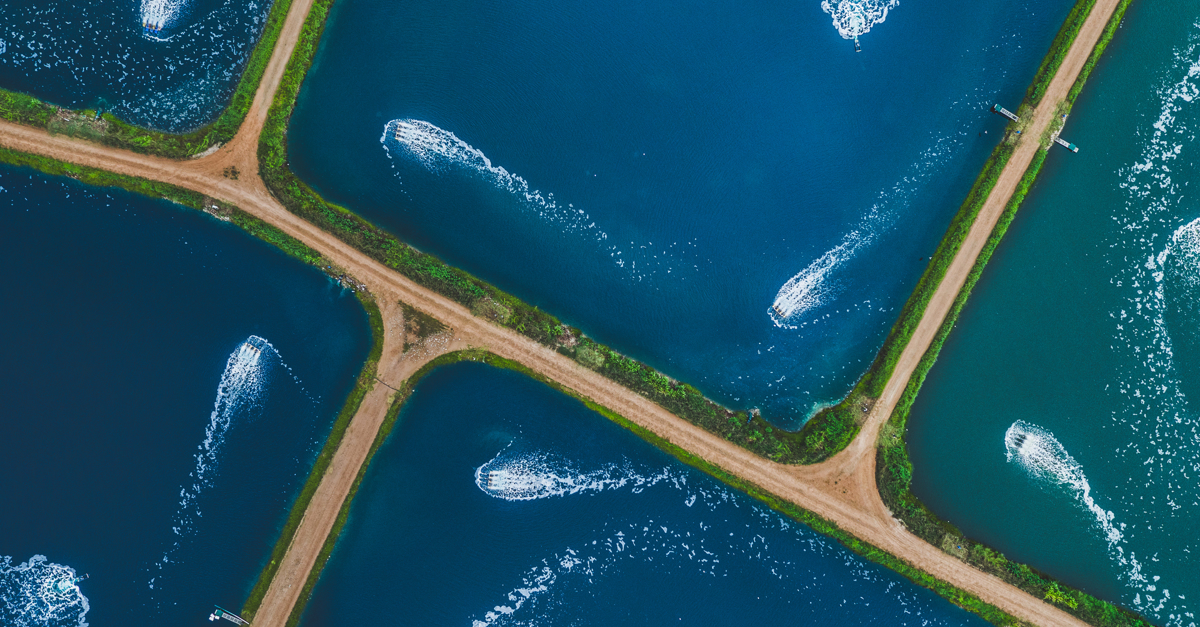
Mangrove forests have long been recognised for their diverse set of ecosystem services including carbon sequestration, biodiversity and protection from tropical storms and tidal surges.
But in the river deltas of southern Bangladesh, this important role of mangroves has had to take second place. Rising sea levels have forced farmers to abandon their rice crops in droves and they’ve had to find other ways to make a living from the land.
Instead, shrimp farms – which are endorsed by the Bangladeshi government and a host of development organizations including The World Bank – have taken precedence.
“This shouldn’t be surprising” says Maksudur Rahman, conservationist and founder of the Bangladesh Environment and Development Society (BEDS). “For many who reside near the coast, the aquaculture industry is their only source of income.”
The Food and Agriculture Organization (FAO) of the United Nations estimate that about 4.5 million tonnes of farmed marine shrimp entered the international trade in 2019 – that’s more than the amount caught by fishing. Notably in China, shrimp exports increased by over 180% in that year alone.
The drawback to this growing market for farmed shrimp is that it comes with a significant ecological trade-off: mangroves are often felled for shrimp ponds.
The Challenge
There are a number of problems caused by this trade-off between shrimps and mangroves:
- The construction of ponds, embankments, and other farming infrastructures can lead to coastal erosion and unwanted interference with hydrology, as they replace mangrove habitats crucial to protecting these processes.
- These practices require significant inputs of feed to boost shrimp production. A considerable portion of this feed then enters the water as metabolic waste, polluting the water which in turn leads to shrimp disease.
- Inadequate management practices and poor pond construction hinder proper drainage, which exacerbates the problem. This poses a significant threat to the survival of mangrove trees and as a consequence many previously thriving ponds have been left abandoned or devoid of life.
- The abandonment of ponds has become an increasingly pressing issue, and intensifies the hardships faced by local communities. Shrimp aquaculture relies heavily on shared resources such as mangroves and water, which have traditionally served as vital economic assets for marginalized households. As a result, shrimp farmers and agriculturalists have experienced displacement and marginalization, leading to socio-economic challenges within these communities.
The Solution
Recognizing the ecological trade-offs and socio-economic challenges posed by conventional shrimp farming practices is the first step to help tackle this challenge. Recently, a promising solution has emerged – a new approach referred to as integrated shrimp-mangrove aquaculture. This seeks to harmonize shrimp production with the preservation and restoration of mangrove ecosystems, and thus promises a more sustainable and resilient alternative.
One of the key principles of integrated shrimp-mangrove aquaculture is the use of mangroves as a natural filtration system. Mangroves have intricate root systems that act as natural purifiers, and they enhance water quality by filtering out pollutants and excess nutrients. This helps to mitigate water pollution issues commonly associated with traditional shrimp farming practices.
In this integrated system, carefully designed shrimp ponds are constructed within or adjacent to mangrove areas, which allows a mutually beneficial relationship to be established. The mangroves provide a protective buffer against erosion, tidal surges, and storms, which reduces the vulnerability of shrimp ponds to adverse environmental conditions. The mangrove ecosystem also provides a natural food source for shrimp, which reduces the reliance on external feed inputs.
Another crucial aspect of integrated shrimp-mangrove aquaculture is the restoration and conservation of mangrove forests. Efforts are made to rehabilitate degraded mangrove areas by replanting native mangrove species. This not only helps to recover lost habitats but also enhances the overall resilience and biodiversity of the ecosystem.
Integrated shrimp-mangrove aquaculture also promotes sustainable land and water management practices. Proper infrastructure is designed to allow controlled water exchange between the shrimp ponds and the surrounding mangrove areas, rather than limiting or completely cutting off drainage. This includes optimizing pond drainage systems to prevent stagnant water and minimizing the risk of disease outbreaks. Thus, a harmonious balance between the needs of both systems is ensured.
The benefits of integrated shrimp-mangrove aquaculture extend beyond ecological impacts and also encourage local economic growth This approach offers new job opportunities for local communities, particularly those residing in coastal areas, to diversify their livelihoods.
“It’s important we work with the local people, including shrimp farmers, to develop their capacities to minimize erosion and salinisation” says Rahman.
He adds “If we create incentives for proper waste treatment and biofiltration, we will have made progress on finding harmony between people and nature. That is our goal”.
Certification may also be one way forward for maintaining ecosystem health and food safety in aquaculture products. In 2015, 95% of Belize’s shrimp production was certified under the Aquaculture Stewardship Council (ASC).
By implementing standards for water quality management and adopting practices for proper waste retention and treatment, the adverse effects of pollutants can be reduced if not removed entirely. This further establishes a stable and consistent source of employment for the local community, offering economic security.
For women in local populations, this integrated approach increases the prospects for them to actively participate in various aspects of the system, which in turn empowers them and fosters gender equality.
It’s important however, that we don’t rely exclusively on certifications and instead focus on the actual impact. Unusual shrimp mortalities that occurred in Belize in the same year as their accreditation were later identified as due to Vibrio parahaemolyticus-related EMS (early mortality syndrome) – a bacterial infection. This serves as a reminder of the need for continuous monitoring and improvement in aquaculture practices, even if certain standards have been met for accreditation.
To fully and properly address the various challenges, integrated shrimp-mangrove aquaculture needs ongoing research, stakeholder collaboration, and community engagement. This will help to further develop and implement sustainable strategies that ensure the coexistence of thriving shrimp farms and healthy mangrove ecosystems.
Dare’s Approach
Dare is committed to supporting nature-based solutions that improve both environmental health and the overall livelihoods of communities most affected by climate change.
In partnership with BEDS (Bangladesh Environment and Development Society), we are dedicated to securing a sustainable future for the region.

